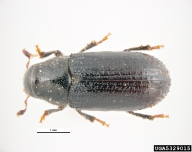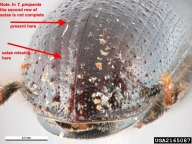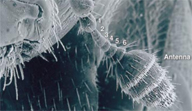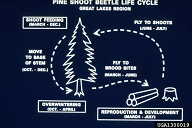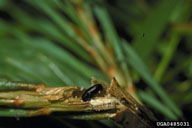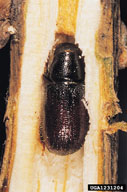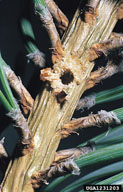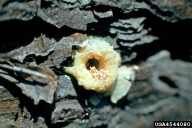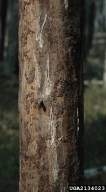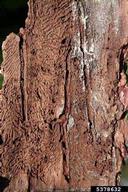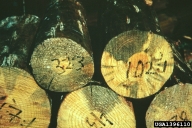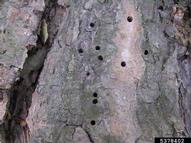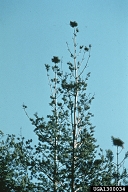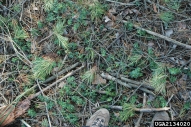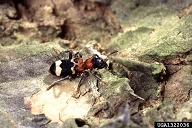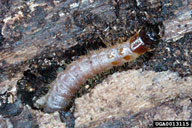Larger pine shoot beetle
Tomicus piniperda (L.) (Coleoptera: Curculionidae, Scolytinae)
Orientation to pest
The larger pine shoot beetle, Tomicus piniperda (L.), is an invasive species in North America that is found throughout much of Europe, as well as parts of North Africa (Algeria, Canary Islands) and Asia (China, Japan, Korea, and Turkey). Both larvae and adults are damaging to a wide variety of pines. Larvae develop under bark of branches and trunks of suppressed or recently fallen trees, as well as in recently cut stumps. Adults cause more important damage by tunneling in live shoots and leaders of healthy pine trees, reducing growth and deforming tree shape, which can cause important losses in Christmas tree production. Larger pine shoot beetles overwinter as adults in short galleries in the outer bark of host trees near the ground. Adults emerge in late winter or early spring and construct brood galleries in suitable host material. At times, these parent adults (P1) will emerge, shoot feed, and then construct another brood gallery. The brood adults (F1) emerge in summer and fly to the shoots of pine trees where they feed until fall. A single brood adult (F1 generation) will feed in multiple shoots during the summer months. Brood adults do not become sexually mature until they overwinter.
The larger pine shoot beetle is also believed to vector or be associated with several fungi that are pathogens in conifers, including Ophiostoma minus (Hedgc.) Syd. et P. Syd., and various blue-staining fungi such as species of Leptographium. Outbreaks of this pest are triggered when there is a sudden increase in the amount of breeding material available in early spring, such as following severe winter storms, winter logging operations, or Christmas tree plantations with recently cut stumps or piles of unsold trees. Silvicultural practices during fall and winter such as reducing the amounts of pine logging slash left in the forest and cutting stumps low to the ground will limit number of breeding sites available for this bark beetle.
Hosts commonly attacked
The preferred host in Europe and so far in North America is Scots pine (Pinus sylvestris L.), but other native pines such as red pine (Pinus resinosa Sol. ex Aiton) are commonly infested. However, all native North American pines are potential hosts.
Distribution
Native to Eurasia, this species is invasive in parts of the United States, from Wisconsin to Maine and south to West Virginia.
 National Agricultural Pest Information System
National Agricultural Pest Information System |
| Figure 1. Distribution of the larger pine shoot beetle as of 2005 |
Images of larger pine shoot beetle
| Figure 2. Adult of larger shoot beetle, Tomicus piniperda | Figure 3. Diagnostic characters for recognition of larger pine shoot beetle: (a) absence of setae in the second row (counting from the midline), toward the rear of the beetle (left) and (b) a six-segmented funicle preceeding the anntennal club. | Figure 4. Seasonal life history of the larger shoot beetle in the Great Lakes region of the United States |
| Figure 5. Adults of larger shoot beetle, showing how adults bore into shoots causing them to die and fall off. Left, adult boring into shoot; middle, adult inside feeding tunnel in shoot; right, opening in shoot made by adult beetle to enter feeding site. | Figure 6. Pitch tubes of larger shoot beetle on trunk | ||
| Figure 7. Galleries of the larger pine shoot beetle; left, see the deeply etched vertical oviposition galleries and right, larval galleries radiating out horizontally from the vertical oviposition gallery. | Figure 8. Blue stain damage in logs affected by the larger shoot beetle | Figure 9. Exit holes of the larger shoot beetle | |
| Figure 10. Tops of pines (left) showing loss of branches from feeding of adults of larger shoot beetle; fallen branches (right) caused by adult feeding. | Figure 11. An important predator in Europe of the engraver beetle, the red-bellied clerid beetle, Thanasimus formicarius (L.) (left, adult; right, larva) |
Important biological control agents related to this pest species
A variety of natural enemies have been recorded attacking the larger pine shoot beetle in Europe, especially the clerid predator Thanasimus formicarius (L.) and the pteromalid parasitoid Rhopalicus suspensus Ratz., both of which at some times and places have been observed to kill 70-80% of the larger shoot beetles larvae or pupae.
Web links for information on larger pine shoot beetle
- Featured Creature Fact Sheet | University of Florida and FDACS
- Fact Sheet from Global Invasive Species Database | Invasive Species Specialist Group
Includes discussion of introduction routes for this species - Pest Alert | USDA Forest Service, Northeastern Area
- Wikipedia Article | Wikipedia, the free encyclopedia
Articles
- Morgan, R. E., P. de Groot, and S. M. Smith. 2004. Susceptibility of pine plantations to attack by the pine shoot beetle (Tomicus piniperda) in southern Ontario. Canadian Journal of Forest Research 34 (12): 2528-2540.
- Kennedy, A. A. and D. G. McCullough. 2002. Phenology of the larger European pine shoot beetle Tomicus piniperda (L.) (Coleoptera: Scolytidae) in relation to native bark beetles and natural enemies in pine stands. Environmental Entomology 31: 261-272.
